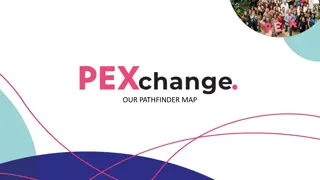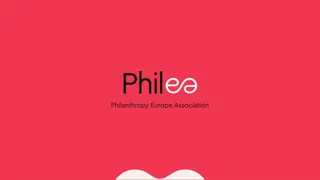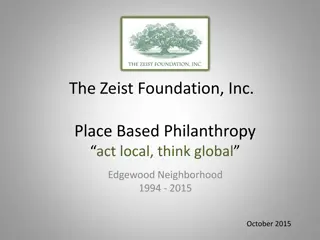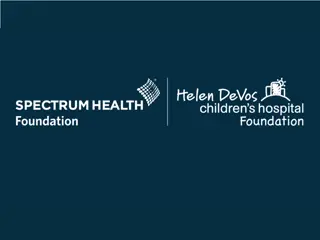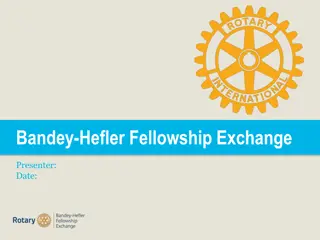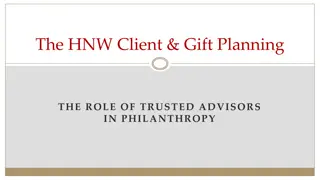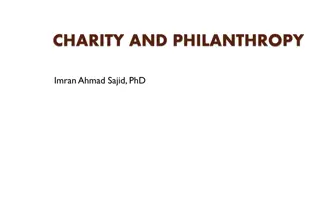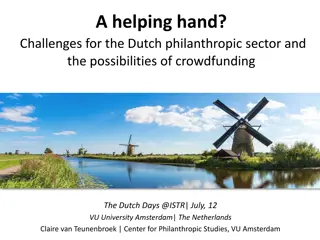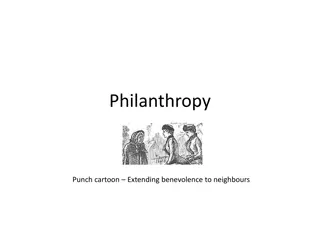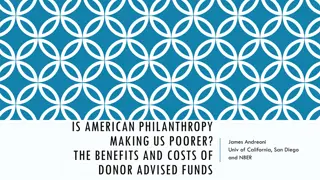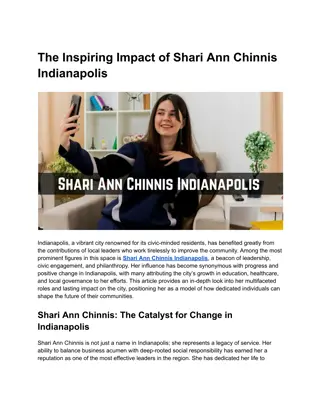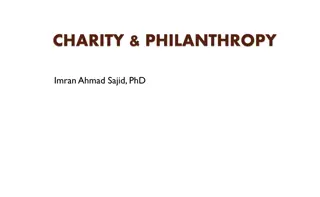
Arts Philanthropy: Turning Patrons into Donors for Cultural Causes
"Learn why philanthropists should support cultural causes, the impact of arts and creativity on communities, and best practices for engaging philanthropists in arts philanthropy. Explore motivations, barriers, and responses to the COVID-19 pandemic in arts philanthropy."
Download Presentation

Please find below an Image/Link to download the presentation.
The content on the website is provided AS IS for your information and personal use only. It may not be sold, licensed, or shared on other websites without obtaining consent from the author. If you encounter any issues during the download, it is possible that the publisher has removed the file from their server.
You are allowed to download the files provided on this website for personal or commercial use, subject to the condition that they are used lawfully. All files are the property of their respective owners.
The content on the website is provided AS IS for your information and personal use only. It may not be sold, licensed, or shared on other websites without obtaining consent from the author.
E N D
Presentation Transcript
Sir Vernon Ellis Arts Philanthropy
Turning patrons into donors Turning patrons into donors
Route to increased donor participation Route to increased donor participation
The case for support for the sector Why should philanthropists support cultural causes? What makes the arts deserving Why should philanthropists support cultural causes? What makes the arts deserving of their donations? The answer to these questions is practical and straightforward of their donations? The answer to these questions is practical and straightforward the arts, culture and creativity change lives. They promote wellbeing, ease loneliness, the arts, culture and creativity change lives. They promote wellbeing, ease loneliness, and enable individuals and communities to tell their stories, among many other and enable individuals and communities to tell their stories, among many other benefits. benefits. Sir Nicholas Serota, Chair Arts Council England March 2020 New Philanthropy for Arts & Culture
Anna Rowe New Philanthropy for Arts & Culture ABO Conference Leeds, 2 Feb 2023
NPAC Background - Understanding arts philanthropy Develop a new arts focused cause-related network: Provide a case study into best practice for engaging and supporting philanthropists Create a framework for operation, and explore different membership models Understand philanthropists motivations and barriers to giving Research existing philanthropists routes to philanthropy Beacon research into barriers for giving Philanthropists response to COVID-19 pandemic: what can we learn? Beacon surveyed 1,300 HNW individuals in summer 2019 20% of respondents identified arts and culture as one of 3 preferred areas of interest Both education and health attracted a higher % This suggests that arts in education and arts in health might attract additional support Research also confirmed the importance to donors of the impact of their philanthropy New Philanthropy for Arts & Culture
Impact as a unifying cause and driver of support Understanding the impact of the Arts Understanding the impact of the Arts Initial hypothesis was that sector impact on community, wellbeing, health and education could be driver of support But impact defined differently by each organisation 40 case studies compiled from database of 150 Clear that significant resource required to scale up activity nationally We believe that the most effective way of leveraging a powerful narrative of the value of arts and culture is through more focused common cause networks Creating a Cause Creating a Cause Increased importance of a local focus (beneficiaries, supporters) Common cause to be created around the vital role of the arts and impact on creativity, economic activity, education, wellbeing, health and the community Particularly challenging for smaller, under-resourced arts companies in regions where the levelling up agenda is most urgent and philanthropy is very limited We concluded that there is potential to create a unifying cause in specific We concluded that there is potential to create a unifying cause in specific places to drive new philanthropy to support the sector in each location places to drive new philanthropy to support the sector in each location
NPAC current work - mobilising philanthropy Creating cause related place-based networks Core Cities Leadership presentation opened up conversations across England Discussions in Sunderland, Birmingham, Stoke, Hastings, Leeds, Newcastle Different models for operation emerging, around impact of the arts in each place Developing a framework for attracting the next generation of arts trustees and philanthropists New funding models to drive philanthropy NPAC work focused on development of a matched funding model for the sector Developed a theory of change around place-based matched funding BCG research into international case studies included several successful models Toolkit for arts organisations new to philanthropy artsphilanthropy.org.uk New Philanthropy for Arts & Culture
Local partnership model - Sunderland Local cultural Increased funding for Arts & network created by fundraiser partnership Fundraising and philanthropy MAC Trust, Sunderland University, Sunderland City Council Cultural organisations Local delivery Sunderland Culture vehicle Opera Sunderland; Young Asian Voices; The Cultural Spring etc. NPAC support
Cultural compact led model - Stoke Increased individual support Enlarged group of Stoke Existing local partners Local delivery vehicle to Create Stoke wide and philanthropists receive contributions Events in Stoke and London for Arts & Cultural (local and other) philanthropists narrative organisations Optional stage Stoke Creates Made in Stoke NPAC partnership, enabling and support
Local government led model - Birmingham Increased individual support Initial conversations with NPAC advocacy as catalyst pan region arts trustees organisation chairs and Networks of grassroots Local Government and arts organisations and Local delivery vehicle to receive contributions for Arts & Cultural cultural partners Launch event in Birmingham their trustees organisations Optional stage Mayor of the West Midlands Birmingham City Council Culture Central
A place-based approach key learnings Personal connections: fledgling groups have come about due to the use of personal connections and, usually, a peer to peer ask Future recruitment: in time recruitment to be broader Partnership: the broader the range and scale of the partners involved, the greater the impact of any work that's delivered Good governance is key and particularly having a strong Chair will provide the greatest likelihood of success Management of different agendas in each location can be challenging Brokerage is attractive to some philanthropists Locally based leadership / administrative support is required Time: the time to set up a new network should not be underestimated Next steps: aim to develop four new locations per year.
Nurturing the next generation? Several have expressed concern about identifying the next generation of arts supporters Starting to develop a model to attract young professional trustees Focus on creating diverse pool of trustees Some NPAC members have already expressed interest in mentoring Young professional trustees will in time mentor their successors Recruitment ideas Partner with major employers Link with leadership training programmes Professional development such as the Forward Institute Fellowship
A next gen model? Responsible Influence in Arts & Culture or RIAC to create new network of young trustees: riac-uk.org Mentorship of RIAC trustees to be provided by NPAC members and their contacts Partner arts organisations to be identified with board needs, primarily smaller organisations In time partnerships to be created with employers to identify next gen trustees


